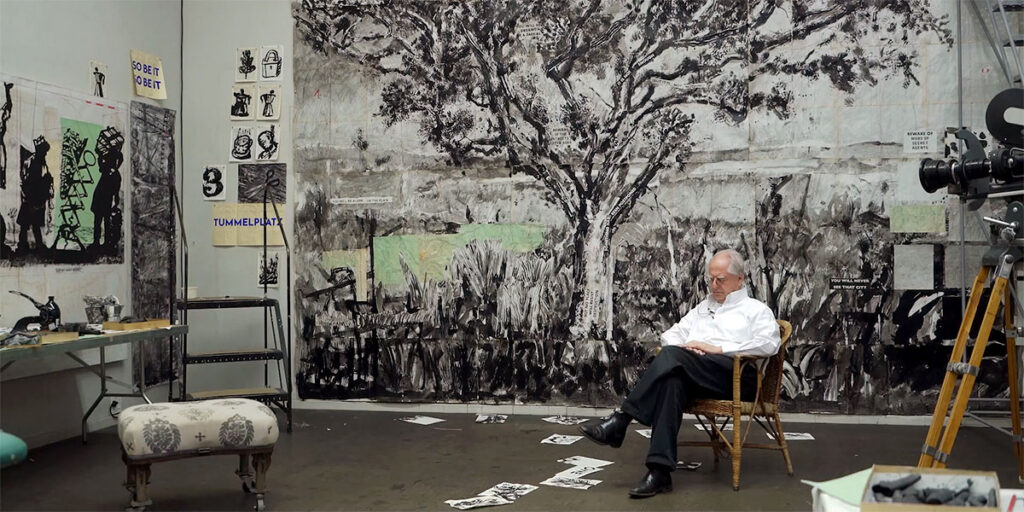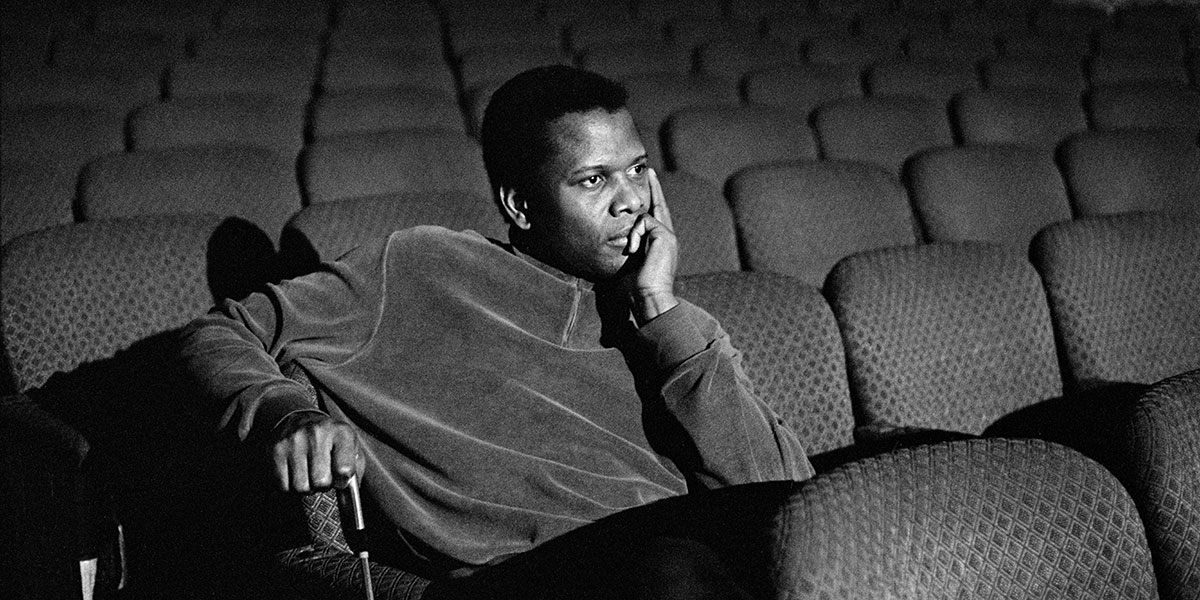If there’s a clear winner of the fall festival circuit, it’s Laura Poitras. The director’s TIFF Docs selection All the Beauty and the Bloodshed was the only film to hit the four big players: Venice, Telluride, Toronto, and the forthcoming New York Film Festival. That’s an impressive feat for a documentary, and one that arguably worked in the film’s favour. Reviews from Venice and Telluride helped to generate interest beyond hard-core doc fans. After the film won the Golden Lion at Venice—a second for a documentary and only the seventh win for a woman director—it became one of TIFF’s must-see films, and rightly so.
All the Beauty and the Bloodshed was the clear standout of the documentary field at TIFF this year. (I managed to see all the documentaries at TIFF this year aside from Mariupolis 2, The Return of Tanya Tucker, Dear Mama, and, unfortunately, Good Night Oppy.) Poitras’ film is simply on another level as it deftly crafts the story of photographer Nan Goldin and her fight against the Sackler family of Purdue Pharma within a larger history of American greed, the failure to hold powerful people accountable for their actions, and art’s ability to confront the establishment. The film taps into the unease of the ever-widening rich/poor gap, and the social inequalities that have exploded during the pandemic. The doc’s finale in which Goldin shares her impact statement to the Sacklers via an impersonal Zoom call feels appropriately cold as the family observes uninterested and unmoved. Bloodshed is Poitras’ best work yet, and arguably one of the clear awards season frontrunners to emerge from the festival.
Ace Arts Docs
Curated by programmer Thom Powers, the TIFF Docs programme again delivered a robust range of documentaries featuring innovative techniques and singular voices. The TIFF Docs opener, Louis Armstrong’s Black & Blues, got the programme back into theatres with a high note. Directed by Sacha Jenkins, Black & Blues is a jazzy number that explores the life and legacy of the trumpeter. The film features a lively score by Terence Blanchard that riffs with Armstrong’s music quite seamlessly. Jenkins’ doc isn’t a one-note celebration, though. The film features a chorus of talking heads and archival snippets that situate Armstrong’s performance style within a larger history of representation. It confronts charges that Armstrong played an “Uncle Tom” character who appeased white audiences, but the musician’s contemporaries counter in his defense. They argue the opposite and credit him for carving out space for Black representation.
Black & Blues complements TIFF’s other star-studded doc, Sidney, which screened in the Galas line-up. The film by Reginald Hudlin paid tribute to Oscar winning actor Sidney Poitier. Perhaps more conventional than Black & Blues with its cradle-to-grave story structured around a key interview, Sidney hits many of the same thematic notes as the Armstrong doc. Both films consider the complexity of breaking barriers for representation and the weight that brings. Both films will be playing on AppleTV+ this fall with Sidney deputing Sept. 23. They’re both worth seeking out as two of the more notable arts docs of the season, as is Brett Morgen’s electrifying David Bowie doc Moonage Daydream, which is now in release.

International Voices
TIFF Docs also got musical with the North American premiere of Miúcha, The Voice of Bossa Nova. Although not quite as showy as fellow arts docs, this film by Daniel Zarvos and Liliane Mutti is a lovingly composed portrait of Heloísa Maria Buarque de Hollanda, aka Miúcha, the comparatively obscure voice reared on samba and jazz. The slice of world music is a dazzlingly artistic celebration. While one might be familiar with the tunes of Louis Armstrong and Davis Bowie, Miúcha will have audiences tapping their feet even if they’re encountering Miúcha for the first time.
Two Canadian music docs also brought rock star status to the festival. Buffy Sainte-Marie: Carry It On is a relatively straightforward doc portrait, but director Madison Thomas gives the artist and activist the tribute she deserves. It’s a winning testament to a woman who broke ground for Indigenous voices and consistently reinvented herself as an artist. As with Poitier in Sidney, Sainte-Marie is a true raconteur, so it’s hard to fault any film that lets its subject tell her own story on her own terms in such a captivating and entertaining fashion.
The film is in good company with Chelsea McMullan and Tanya Tagaq’s Ever Deadly. This NFB doc highlights Tagaq’s singular voice. Ever Deadly has one of the most memorable openers of any doc this year as the film features Tagaq in a magnetic close-up with fellow throat singer Laakkuluk Williamson Bathory. The seven-minute sequence perfectly contextualizes the call-and-response structure of throat singing that Ever Deadly adopts. Tagaq appears in concert footage crosscut with images of her life up North. Ever Deadly plays as a call and response between legacies of violence and systemic abuse that Indigenous communities face, and Tagaq’s ability to give voice to said pain through her cathartic music.
Ink and Celluloid
Ever Deadly’s fellow NFB doc The Colour of Ink by Brian D. Johnson, meanwhile, has a scope both local and global with its portrait of ink aficionados. The film observes Torontonian Jason Logan as he forages for materials with which he creates artisanal ink. Johnson follows Logan as he and his ink travel the world and contribute textures and hues to tattoos on bodies, gigantic murals in Japan, and lifelines that immortalize loved ones. With cinematography by Nick de Pencier, the film enjoys some visually rich explorations of ink’s movement across the canvas as Logan and artists worldwide forge unique creations. This is a wonderful film for viewers who savour the handcrafted and artisanal.
Similarly, audiences should relish the scratches and crackles on old film reels in Ciné-Guerrillas: Scenes from the Labudović Reels. The film by Mila Turajlić opens the archives to unearth footage shot by cinematographer Stevan Labudović during the Algerian resistance to French occupation. Ciné-Guerrillas shares film’s ability to bring truth to light as Labudović revisits how he and members of the resistance used the power of 35mm to counter the narrative of mainstream news. The film is a refreshing slice of history told by those who lived it.
Similarly, the power of film receives personal consideration in Patricio Guzmán’s documentary My Imaginary Country. The film sees the Chilean master in top form as he examines the waves of protest that rocked his homeland during 2019-2020. Guzmán contextualizes the student protests within the images of his earlier films as he looks back at the days of Allende and Pinochet that he endured years prior. My Imaginary Country takes a refreshingly intergenerational approach to stories of resistance and protest as Guzmán finds inspiration in the young people who summon the rabble and fight for change.
Truth and Exposés
One reason that All the Beauty and the Bloodshed fittingly encapsulates the best that TIFF Docs had to offer, moreover, is that it bridged the thematic links of the line-up. On one hand, its portrait of Nan Goldin and her photography offers a through line within the larger field of docs like My Imaginary Country about artists and the movements that give rise to their work. On the other hand, Poitras’ timely exposé makes the film a work that is truly of the moment. It captures the zeitgeist in a way that few films do, although a handful of films in TIFF Docs join All the Beauty and the Bloodshed in tackling the 24/7 assault on truth and reason.
Vinay Shukla’s While We Watched, for example, powerfully captures the state of independent news media with its portrait of Indian journalist Ravish Kumar. The film, which won an Amplify Voices Award at the festival, sees in one reporter’s story the larger fight worldwide to tell stories with fact-checked authority. While We Watched is equally maddening and invigorating as it sees Kumar and his beleaguered, cash-strapped newsroom try to keep pace amid a sea of alternative facts and fake news stories spouted by louder voices with larger platforms. The film is an unnerving portrait of a battle that newsrooms with integrity seem to be losing—but it’s ultimately a hopeful portrait with its look at Kumar’s tenacity and perseverance.

The Grab and Free Money
Similarly, Gabriela Cowperthwaite’s The Grab is one of the stronger titles from the TIFF Docs line-up with its portrait of long-form investigative journalism in action. The film observes journalist Nathan Halverson as he follows the money to investigate a global network of land grabs and resource exploitation that is directly linked with wars and human rights violations worldwide. The Grab provocatively connects the dots amid myriad stories thanks to the journalistic rigour at the film’s core. Cowperthwaite and Halverson offer a treasure trove of information that should inspire jaw-drops and rallying cries alike. It’s a tautly constructed feat that every viewer feeling the pinch over food prices needs to see.
Many of the items raised in The Grab echo throughout Lauren DeFilippo and Sam Soko’s Free Money. The film considers the pros and cons of universal basic income (UBI), as well as the intentions of the hands that give. Free Money takes audiences to a small African village where start-up NGO Give Directly tests a pilot project for UBI. The film sees firsthand how some people flourish with the modest monthly stipend they receive to meet their basic needs. Alternatively, DeFilippo and Soko observe the failures of the system when it doesn’t provide equitably and adequately, and when there is no long-term plan to build sustainable infrastructure. The project still has a decade to go, so Free Money can only raise questions in lieu of providing answers. However, it offers an objective field of factors to consider, particularly as docs like The Grab and All the Beauty and the Bloodshed illustrate how the might of capitalism bleeds the world dry. A follow-up documentary is both inevitable and welcome.
Pushing Against the Status Quo
Other notable titles in TIFF Docs similarly use the power of documentary to challenge authority. Two films smartly put the talking heads format of documentary to good use: Pray for Our Sinners and Casa Susanna. Directed by Sinéad O’Shea, the former looks at the legacy of violence inflicted upon young people, particularly women, in Ireland by the Catholic Church. O’Shea challenges the norm of her hometown Navan, which pushes the ever-so-Catholic mentality to keep mum. She digs into the stories of abuse and corporal punishment that young people experienced in a nation with an unholy marriage between church and state.
O’Shea draws devastating stories from survivors, including women who lost their babies to a system that was unforgiving to unwed mothers, as well as perspectives from community members who exposed abuse and paid a price. Pray for Our Sinners gets uncomfortably close to spirit that endures in the community as O’Shea zeroes in on one priest who was particularly brutal in his application of God’s wrath. However, the truth that O’Shea discovers is not the one that she expects. The film therefore invites audiences to see how good people can do terrible things, and how a community turns a blind eye because it’s easier to look away than to confront horrors staring people in the face.
Alternatively, Casa Susanna offers a joyous study of a community of transgender women who came together in the Catskills. Directed by Sébastien Lifshitz, Casa Susanna assembles surviving queens and features a handsome array of photographs that show how one tightly knit oasis saved many lives. Lifshitz draws moving direct-address interviews from the women who reflect upon being a transgender person at a time when no word existed in popular use to help them discover their true selves. The women, along with younger family members of queens no longer with us, look back at years when cross-dressing was seen as an aberration and when homosexual acts were crimes. Casa Susanna confronts this all-too-recent history to invite audiences to consider the changes that still need to be done, but also to embrace with open, loving arms the people who create safe spaces for others to grow.
Innovations in Documentary Form
No survey of the TIFF Docs selections would be complete without peeking into the titles that advance the art form. Perhaps the most innovative work in the programme was Self-Portrait as a Coffee Pot, directed by William Kentridge. This eclectic doc series, of which three episodes screened in TIFF Docs, sees Kentridge fuelled by creativity and passion amid the COVID lockdowns. This thrillingly unique work captures creative synapses firing as Kentridge throws himself into his art.

The South African artist creates unconventional portraits that confront larger national narratives of power and control. Moreover, Kentridge plays fast and loose with documentary form, often putting himself in conversation with himself through nifty camera tricks. The film invites audiences to question everything they see and to be cognizant of the construction behind every image and story they encounter. Most refreshingly, Self-Portrait as a Coffee Pot captures the frenzy of madness experienced worldwide during the quarantine days. No film encapsulates the restlessness of the COVID days quite like this one, but also the itch many of us felt to put this time to good use. (Alternatively, Werner Herzog’s Theater of Thought has great ideas, but feels flattened by COVID-era production constraints.)
Perhaps the most pleasant addition to documentary at TIFF Docs, however, was not a documentary at all. The appearance of the popular parody series Documentary Now! brought the house down with uproariously funny takes on the art form. The inclusion of a spot-on parody of My Octopus Teacher was especially riotous alongside fellow TIFF Docs selection Patrick and the Whale, which could have easily been confused for the spoof of the Oscar winning film that doc fans love to hate. Documentary Now! smartly calls out all the rote clichés of My Octopus Teacher’s formula that Patrick and the Whale adopts. On the other hand, Documentary Now! features some of the sharpest observations of the mastery of non-fiction filmmaking with its deadpan accurate lampoon of Agnès Varda’s offbeat personal filmmaking and its loving salute to the BBC with a sketch starring Cate Blanchett and Harriet Walter.
Industry Talks
The doc crowd got serious, though, when the annual Industry Conference returned with a day devoted to documentary, which, of course, featured Poitras as the headliner. The director participated in an extended conversation with programmer Thom Powers, who walked Poitras through her process. Poitras emphasized the collaborative nature of her relationship with Goldin, who is credited as producer on the film, but ultimately generated the most discussion of the day by shifting her attention away from the film. Poitras pointedly called out the Festival for giving former Secretary of State Hillary Clinton a platform when American administrations are failing to protect the freedom of the press. (Clinton was at the festival as executive producer of the powerful Netflix doc In Her Hands and to participate in an extended conversation about her Apple series Gutsy.) Poitras challenged Clinton to put her power to use by facilitating the release of WikiLeaks founder Julian Assange, subject of the filmmaker’s documentary Risk. Powers handled the challenge admirably and engaged Poitras in a conversation that segued appropriately to the subsequent industry talk with Vinay Shukla.
Another challenge was gamely issued in the industry forum’s final session, DocuMentality. Featuring DocuMentality team member Malikkah Rollins, the Documentary Organization of Canada’s Sarah Spring, and filmmaker Rebeca Huntt (Beba), the session outlined concerns for addressing the mental health of filmmakers as they devote long hours to their documentaries, often dealing with subject matter than can be (re)traumatizing. The session, which could easily have given another hour to the conversation, built upon focus groups performed by DocuMentality and offered actionable items, like factoring wellness into budgets, as well as provisions like childcare that affect a filmmaker’s well-being during long production days. DOC is following the effort by issuing a survey of its own, which filmmakers are invited to complete here.
Award Winners
While Poitras didn’t add a TIFF award to her Golden Lion, the festival offered a few surprises itself with the winners. The awards announcement illustrated that 2022 was a good year for Canadian docs at the festival as Hubert Davis’s Black Ice won the People’s Choice Award for documentary. The film, which screened as a Gala, is a bold study of racism in hockey. Davis’s slickly assembled film draws generations of players together for an open and candid debate about equity and access in “Canada’s game.” Canadian doc 752 Is Not a Number joined Black Ice in the top docs, as it was the second runner-up in the audience rankings with American doc Maya and the Wave pulling the first runner-up spot for its invigorating portrait of Brazilian surfer Maya Gabeira and the sexism she faces as a pro athlete.
The jury for the Amplify Voices awards, meanwhile, got it right when it awarded Best Canadian Feature to Nisha Pahuja’s To Kill a Tiger. The film, easily the best overall Canadian work at the festival, offers a gripping portrait of love as a father supports his daughter in her quest for justice following a violent rape. To Kill a Tiger is the result of a filmmaker embedding herself Poitras-style within the lives of her subjects, and offering an empathetic, yet unobtrusive platform with which they can share their story. The film’s observation of consent, family, and accountability complements many of the themes raised elsewhere in the TIFF Docs programme. One hopes the TIFF win will help Pahuja’s film break through on the international circuit and bring the story of the family’s fight to more audiences, just as the Venice win for Poitras gives her doc a wider platform.













